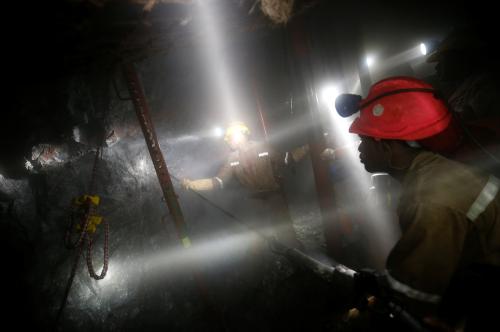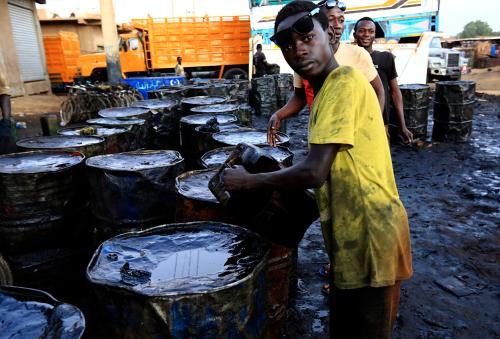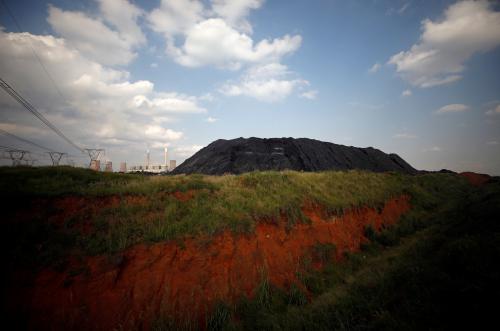In a forthcoming study analyzing how resource-rich sub-Saharan Africa can reinvigorate its growth, my co-authors and I were surprised by a few findings. In this blog and in the study, we rank the resource-rich countries by their aggregate natural resource endowment. The top 10 in sub-Saharan Africa are Nigeria, South Africa, Angola, Equatorial Guinea, Gabon, Sudan, Tanzania, Zambia, Botswana, and the Republic of Congo. For comparison, we also present a group of Africa’s resource-poor countries. The 10 with the least natural capital—the resource-poor sub-Saharan Africa countries—are Seychelles, Saô Tomé and Príncipe, Cabo Verde, Comoros, Gambia, Mauritius, Lesotho, Guinea-Bissau, Swaziland, and Burundi. Their average natural capital per capita is just one-fifth that of the top 10 resource-rich countries.
Finding 1: Africa is rich in natural resources, but its resource wealth is one of the lowest among the world’s developing regions, both in aggregate and per capita terms (Figure 1).
Africa’s natural wealth could rise substantially in a generation, provided natural resource exploration and development of extractive projects picks up—as they did in East Asia and the Pacific and the Middle East in recent decades—the low yields on agricultural crops are given a boost, and more land is brought under cultivation. As noted in a recent Foresight Africa report, at 200 million hectares, sub-Saharan Africa is home to nearly half of the world’s uncultivated land that can be brought into production. Africa uses only 2 percent of its renewable water resources compared to 5 percent globally.
Figure 1. Africa’s aggregate and per-capita natural wealth, 1995–2014
(In US dollars)

Finding 2: Sub-Saharan Africa is strongly dependent on its natural capital.
Natural resources dominate the structure of wealth in Africa: the share of natural capital in the continent’s aggregate wealth is the second highest in the world after the countries that form the hydrocarbon-rich Gulf Cooperation Council (GCC) (Figure 2). Even resource-poor sub-Saharan Africa has a share of natural capital in total wealth that is higher than the resource-rich OECD countries. While paradoxical at first glance, this finding is the consequence of the fact that the contributions of human and physical capital to total wealth are modest both in resource-rich and resource-poor Africa.
Figure 2. Share of natural capital in total wealth by region, 2014
(In percent)

Finding 3: Even with modest natural wealth compared with other regions, resource-rich sub-Saharan Africa is more dependent on natural resources than resource-rich advanced economies and almost as dependent as other resource-rich developing countries.
We measure a country’s dependence on natural resources in three ways: the extent to which the country depends on natural resources exports for foreign exchange, the share of natural resources in its production, and the contribution of resource rents to government revenues (Figure 3). The resource dependence of resource-rich sub-Saharan Africa countries also varies. The Republic of Congo is more dependent than other developing and developed resource-rich countries, including the GCC
Figure 3. Dependence on natural resources, regions and sub-Saharan Africa, 2008, Index

Finding 4: The composition of sub-Saharan Africa’s natural wealth is much more diverse than that of other resource-rich countries.
Oil accounts for 43.5 percent of resource-rich sub-Saharan Africa wealth, substantially less than in resource-rich comparators outside Africa, and land accounts for about 35 percent (Figure 4). Metals and minerals account for 27 percent for Zambia, 26 percent for South Africa, and 14 percent for Botswana. In resource-poor sub-Saharan Africa countries, land accounts for the largest share of natural capital, as much as 60 percent in Tanzania.
Figure 4. Components of natural wealth in resource-rich sub-Saharan Africa, 2014
(In percent)

Finding 5: Africa’s resource-rich countries grew faster than resource-rich comparators in other regions since the start of the 21st century.
This observation, which will be a surprise to many, partly reflects the lower base, but part is also due to strong investment in physical capital because of the spurt of new extraction since 2000 (Figure 5).
Figure 5. Growth in resource-rich and resource-poor sub-Saharan Africa, 1990–2016
(Percent change)

Finding 6: Since 2005, fixed investment by the top-10 resource-rich African countries has been higher than 25 percent of GDP.
This exceeds the threshold than was sustained for several decades by the 13 countries that the Growth Commission (2008) considered the world’s sustainable growth champions (Figure 6). These investment rates reflect the pickup in natural resource exploration this century and the fiscal space provided by debt forgiveness. However, investment rates have been volatile in the resource-rich group.
Figure 6. Fixed investment, resource-rich and resource-poor Africa, 2000–17
(Percent of GDP)

Finding 7: Raising adjusted saving rates in the resource-rich sub-Saharan Africa economies to the levels of the OECD countries will be equivalent to an additional $77 billion invested in produced capital.
This amount is almost five times more than the annual inflows of FDI, and more than three times the annual inflows of remittances. The average rate for Botswana, Tanzania, and Zambia is almost 20 percent; those of Nigeria and South Africa have oscillated near zero; that of the Republic of Congo is a negative 30 percent; and Angola’s is a negative 40 percent (Figure 7).
Figure 7. Adjusted net saving, resource-rich sub-Saharan Africa and comparators, 1997–2015
(Percent of GNI)








Commentary
7 surprising findings about resource-rich sub-Saharan Africa
August 1, 2018